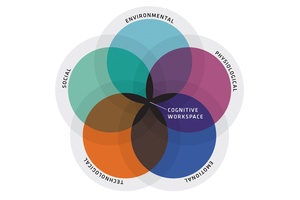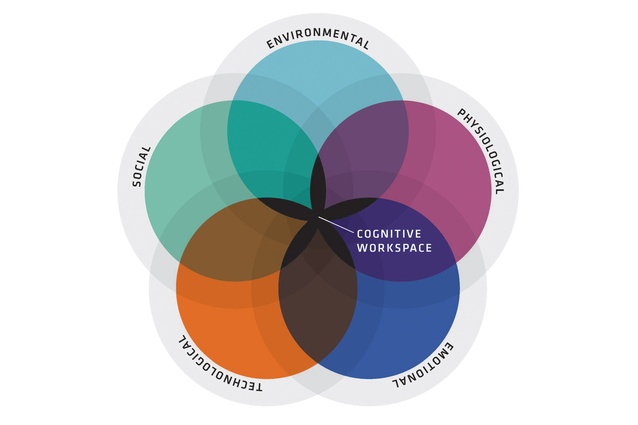The problem with collaboration
Things overheard in the office: A guy goes to work in his open-plan office. He hears his boss arguing with her husband about a pending divorce, the kids and money… It sounds like the beginning of a bad joke, right?
Unfortunately, its not. It’s a paraphrase from a real-life example of someone purportedly working in the North American media market. The open-plan office and collaborative environments are increasingly featured in conversations for the problems they present rather than the benefits. The substance of the comments imply that the open office is synonymous with noisy spaces where colleagues share illness and unintentionally share personal problems via overheard phone conversations.
Media commentary and articles are also more frequent. Recent examples include those in the NZ Herald by Robyn Pearce and the Daily Telegraph. Inevitably the commentaries are directed towards health and privacy. An often cited article is by Dr Vinesh Oommen in the Asia Pacific Journal of Health Management. Dr Oommen cites employees facing “a multitude of problems such as loss of privacy, loss of identity, low work productivity and various health issues, over stimulation and low job satisfaction when working in an open plan. He also cited insecurity over colleagues’ ability to see what they were doing on the computer and eavesdropping on phone calls.

With this wave of criticism and challenges, is the open/collaborative strategy wrong? Is it possibly just engineered hype driven by profit centric interiors teams and suppliers? Perhaps. But then again, perhaps not.
Workplace strategy and the resulting environments are influenced by two broad categories of forces. The first are the micro-level factors which are driven by tactical and short-term influences such as economic interest rates or perhaps changes in political or environmental policy. The impact of these items tends to be shorter, sharper and more visible. They also tend to be influenced by the individual companies directly. Companies can hedge against interest rates, lobby government on policy and even move to different countries to alter the impact of these influences on their business.
The less obvious but more significant influences are the macro items that are beyond the control of any company or government. Examples include areas such as technology, changes in the demographics of the workforce, and sociology.
To illustrate, consider the role of baby boomers on the workforce and workplace design; the role that the internet, Facebook, LinkedIn and texting has played in relationship building; or the role that tablet computing and smartphones has played in the way we work. It doesn’t matter where in the world we work, all of these items affect the way we must design the workplace. Here are some of the key influences that are unavoidable and drive the current collaboration initiative:
Macro Economics:
When Adam Smith wrote his book The Wealth of Nations and established his pivotal practice of division of labor, he ensured that the way we work was forever changed. We are driven by the need for excellence and specialisation is a key path to competitive advantage. And while Adam Smith’s research was first outlined in 1776, more current research has further validated the growing role of specialisation in our workplace.¹
As a result, our ability to completely solve challenges is diminished and our dependence upon other specialists to achieve a quality result has grown at a corresponding rate. Already research is established that of the ten tasks on your desk right now, nine of them require at least one other individual to complete the task. Collaboration is the creation of a result that could not have otherwise been achieved by fewer individuals participating. Thus irrespective of the current buzzword status of collaboration, it is almost inescapably required by firms needing to consider workplace strategy.
And the strategy to this point has generally reflected the need to enhance the frequency and later quality, of human interactions/collaboration.
Further research shows that if your collaborative colleagues are more than 30 meters away they may as well be in another building for the amount of effort we will make to see them.² So again, spatial strategies have reflected the need to bring people closer together.
Technology:
So what about technology? Isn’t that making things easier? After all, technology has made it easier to interact over distance. Technology has historically enabled us to process larger or more complex problems. In fact it would be hard to argue that technology and its rate of improvement hasn’t made us far more effective and productive.
However, at its heart the fundamental problem with collaboration is complexity. In a presentation by Matthew Davies from the Hub, he points out the fact that technology does not always make complex collaborations easier. Matthew’s examples include contrasting the ease of email with parsing an email involving a dozen people. Or the ease of establishing a discussion board with following hundreds of simultaneous conversations. Video chat with a few people is easy. Virtual f2f with thousands is not. The scope and scale that technology enables, does not always make the collaboration potential easier or more effective.
Matthew proposes we consider a team of five individuals. How many two-person channels are there? Answer: Ten. How about for ten people? The answer is 45 not 20. If the potential combinations are unknown then the combinations could add up 252 potentially. If the 5 became 10, then the number grows to 15,500! The key point being underscored here is that technology enables greater interactions but does not necessarily enable the result. The possible answer lies in reducing the complexity and re-enabling human direct interactions. Reduce the unbound complexity and facilitate the interactions.
Noise and Accoustics:
What about noise and distractions? In very basic way, the noise element comes down to a desire to be able to work free of distractions.
Research conducted between 1994 and 2000 by BOSTI³ (Buffalo Organization for Social and Technological Innovation) studied more than 40 companies and 13,000 people. From that research it was discovered the number one trait sought was a distraction-free space to conduct solo focus work. But the answer does not lie in library-level quiet spaces either. In fact the key appears to be around the level of audibility. Research shows that the key is to filter noise and distraction to the level that the conscious mind does not try and attune to other conversations.
If collaboration potential is optimised by unintentional interactions, then the design will be driven by a desire to increase these interactions. Thus the likely strategy appears to be designing solutions that allow for focus activities to be executed elsewhere in the office. For these types of activities, specific acoustic measures can be deployed to mitigate distractions and enable focus.
Conclusion:
While there are some deserved criticisms of the current open-office strategy and further, there are some external forces we can influence, it may be that the macro influences are ones that we can not change and therefore oblige us to adapt. Macro factors such as specialisation of the workforce, the complexity of required collaborations and the fact that technology may not be the sole solution to the problems.
Innovation and design are already seeking out new solutions to mitigating unwanted noise. Passive sound absorbing materials are increasingly deployed in softer workspaces. More sophisticated products are embedding anti-microbial and or anti-bacterial properties in the substrates of products. Just as ergonomics was the tool deployed to counter the growing time spent at a desk, so too will the market respond to these current challenges of open workspaces.
Footnotes:
1. Morello, D., & Burton, B. (2006). Future Worker 2015: Extreme Individualization. Gartner Research Report, Gartner Research.
2 Kiesler, S., & Cummings, J. N. (2002). What Do We Know about Proximity and Distance in Work Groups? A Legacy of Research. In P. Hinds & S. Kiesler (Eds.), Distributed Work. Cambridge, MA: MIT Press.
3 Brill, M, Weiderman S, and BOSTI Association (2001). Disproving Widespread Myths about Workplace Design, Kimball International Blair McKolskey.











